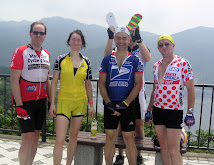When I find equipment that works for me, I like to stick with it -- Fizik Arione saddles, Sapim CX Ray spokes, SP Dynamo hubs, Shimano mtb shoes and SPD pedals, Q36.5 bib shorts, Rain Legs, and on and on. These are all gear or parts I have bought multiple times and used for many years.
The helmet equivalent for me was the Giros Atmos helmet circa 2005-2011. At one point it was Giro's "top of the line" road helmet, replacing the Pneumo, and eventually replaced by the even more expensive Ionos. It was relatively light (~300 grams), and it fit my head perfectly so I would barely notice it was there. I owned two of them. One was discarded long ago, but the second was still on my closet shelf, and often on my head, until quite recently.
I rotated that long-time favorite with various others I bought and tried, none of which has worked quite as well for me -- too heavy, feel weighted toward the front (or rear), not wide enough (or too wide), too tight for a winter cap/liner, not as secure as the Atmos, not as good coverage in event of an impact -- none have been as "just right," as the Atmos was. And over time higher-end helmets got ridiculously expensive, to the point where I always looked for one on sale, a mid-range model that offered most of the performance of the ones that cost twice as much. (Maybe that was why I no longer found one that was "just right?")
But I have read that you should not use a helmet for more than 5 years, nor after it suffers a serious impact. My remaining Atmos had passed at least a decade, and it had had a few impacts, though I suspect it has suffered more impact damage from getting banged up in transit when I travel than actually while protecting my head. In any event, there are visible cracks in the styrofoam, and so I finally discarded it, far after I should have.
The replacement? A relatively inexpensive (63 Euros at Bike24, so around $65 and well under JPY10,000, less than half the ~JPY20,000 price in Japan) Bontrager Specter Wavecell helmet.
This is not a high end, and not particularly light (~360 grams), nor particularly aero helmet. But it fits my head, it looks as if it offers excellent protection, And the "Wavecell" system is said to dramatically reduce the risk of a concussion or other brain injury in a crash ("up to" 48 times lower risk--more like 3 to 12 times lower risk--by one peer-reviewed study ,,, that I think I read included the inventor of the system, who no doubt profits financially from licensing it to Trek/Bontrager). (Trek/Bontrager no longer use the "up to 48" phrasing in their marketing, as they have been sued in a class action, I believe.)
This will be my "go to" helmet for riding in town. And if I like it enough i may take it out on the road as well at times despite the few extra grams. It is a nice compromise. I could only find it on sale in a dark blue/black color. So I have added some reflector strips to both sides and the rear, as well as mounting a small rear flasher light.
What is Wavecell? It is a system of a kind of moveable crush-zone on the inside of the helmet that supposedly reduces the movement of the brain in the head in a crash. This is similar to, but much stronger than, the claims made by MIPS. MIPS helmets also include a kind of second, internal head "harness" inside of the helmet that is designed to reduce harm to the brain from strong rotational force in bicycle crashes. Then again, Virginia Tech publishes an annual ranking of helmets based upon its own safety tests. The Bontrager Specter Wavecell scores very well and gets 5 stars. While it was #1 in 2019, now it is only #22 out of #167 on the list (still listed as 5 stars). Many MIPS and even some non-MIPS helmets now rank slightly higher overall on Virginia Tech's metrics. So while Wavecell's marketing claims ("up to 48 times the protection") are extreme, the actual effectiveness as measured by Virginia Tech seems to be good, and similar to MIPS.
I have a Giant Pursuit MIPS helmet as well, bought in Fall 2021 on sale online (Euro 139?). It is designed to be more aerodynamic than one such as the Bontrager Specter, with vents on front and rear but not top nor sides. But it feels a bit unbalanced on my head at times -- protruding further at front and rear than a "normal" road helmet. It is around 350 grams in the L size. And its matte white finish was quickly (and, seemingly permanently) dirtied by my riding style and/or grimy hands. Maybe the easily dirtied color explains why it was available on sale?
 |
| New |
 |
| Actual -- dirtied. |
 |
| Big front (and rear) vents. No dirty air on top or sides. |
 |
| MIPS system. |
Perhaps my most "aero" helmet, however, is not the Giant Pursuit, but a simple JPY3100 (<$25) Basecamp Shinmax, with integrated visor (attached with magnets). This weighs around 280 grams and is ideal for use with the Pelso since its aero properties are not so heavily dependent on having one's head at the "correct" angle, as I suspect is the case with the Giant Pursuit. No fancy MIPS or Wavecell protection, however, and not on the Virginia Tech list.
I also have a Limar Ultralight helmet acquired on a trip to Europe in 2015. It offers, I am afraid, less protection on the sides and rear, and is a bit narrow/tight for use with winter gear. but it is great for travel, noticeably smaller than others to take attached to a carry-on or stuffed in a duffel, and only a bit over 200 grams in the L size. Upon release, it was marketed as the lightest in the world that meets the EU's safety standards. But I do wonder how good its protection is? Limar helmets do not appear on the Virginia Tech list. Here are some comparison shots with the Bontrager that show the difference in volume. What about the "5 year rule"? Well, it has not been used nearly as much as some others, so for the time being I will keep it in my inventory.
There are lots of other major helmet brands out there -- Kask, MET, Lazer, to start. All of them have candidates that are not outrageously expensive, incorporate MIPS, and look like they MIGHT be my next Atmos ... but a bit less expensive and more aero. We shall see ... within a few years.























































